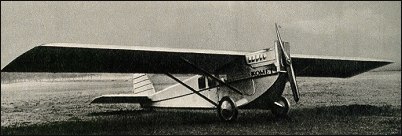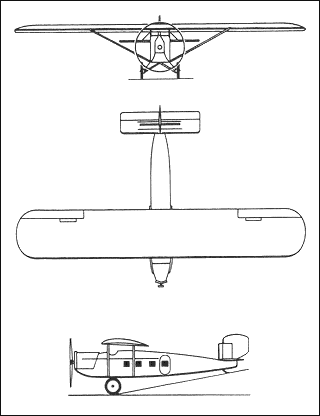|
| Designed in 1920, the Komet II was a five-seat (pilot in open cockpit and four passengers in cabin) monoplane with a thick wing placed on top of the deep box-section fuselage. A small number were built with 134kW BMW IV engines and were operated from 1922 by Deutsche Luft-Reederei, and Rolls-Royce Falcon-engined examples went to Spain, Colombia, Russia and the Ukraine.
Dornier Komet III was a larger and more powerful version of the Komet II type, produced in 1924 to provide higher speed and greater capacity for airline services. Accommodation was for a pilot and mechanic side-by-side in front of and below the monoplane wing and six passengers in the cabin. The wing of this Komet was raised above the fuselage on four short struts. Power was provided by a 268kW Rolls-Royce Eagle IX or 335.3kW Napier Lion engine. Examples were operated by Deutscher Aero Lloyd and DDL in Europe, were exported to the Ukraine and licence-built in Japan and perhaps Switzerland in civil/military guises.
| CREW | 1 |
| PASSENGERS | 4 |
| ENGINE | 1 x BMW IV, 185kW |
| WEIGHTS |
| Take-off weight | 2200 kg | 4850 lb |
| Empty weight | 700 kg | 1543 lb |
| DIMENSIONS |
| Wingspan | 17.0 m | 56 ft 9 in |
| Length | 10.3 m | 34 ft 10 in |
| Height | 3.3 m | 11 ft 10 in |
| Wing area | 50.0 m2 | 538.20 sq ft |
| PERFORMANCE |
| Max. speed | 165 km/h | 103 mph |
| Cruise speed | 135 km/h | 84 mph |
| Ceiling | 5000 m | 16400 ft |
| Range w/max.fuel | 500 km | 311 miles |
| napo, 18.06.2011 12:05 others used the Napier 465 horsepower Lions, and the third powerplant was the 400 horsepower Liberty engine. reply | | Tanino, e-mail, 30.01.2010 21:30 this plane was also called "dornier DO-C" reply | | Barry, 11.01.2010 16:13 There were 3 DornierCIII KometI built all of which were converted to KometII standard. The first Komet II called "Tiger" was a converted KometI and flew on 9 /10 /1922. This aircraft Werk No23 D-223 was the first German airliner to fly from Germany to the U.K. on the 31 /12 /1922. A total of 16 airframes were built some flying until 1934.
There were 18 Komet III built and a number of these were later converted to Merkur. They were sold in Germany, Switzerland and 7 were sold as Do B Ral to Urchwosduchpot in the Soviet Union. reply |
| AndyC, e-mail, 27.02.2009 11:17 See this image for clarification:
www.histaviation.com /Do_Komet_II_361x235.jpg reply | |
| | Andy Campbell, e-mail, 27.02.2009 11:15 I think the three view may be of the later aircraft /development.
If you look carefully at the image you can see the wing on this very early aircraft is mounted on the top of the fuze not on a pylon and the pilot sits through the wing not under it. reply | | stephen winkler, e-mail, 27.03.2007 00:13 This aircraft employed a skid instead of a tail wheel, because most airplanes were designed with skids during this very early period of aviation. The skids were great for braking, but alas, contributed to the structural weakening of the aircraft.
This airplane was one of the first high-wing monoplanes used for commercial purposes. Incidentally, in that connection, all of the first and early monoplanes were high-wing.
The first Komet I used an 180 horsepower engine and the later designs switched to a 185 horsepower engine.
The Komet II used a 250 horsepower engine.
The Komet III used three different kind of powerplants. Some of them employed the Rolls-Royce 360 horsepower Eagles, others used the Napier 465 horsepower Lions, and the third powerplant was the 400 horsepower Liberty engine.
The Merkur used a 600 horsepower engine as its powerplant. reply |
|
Do you have any comments?
|
| 
COMPANY
PROFILE
All the World's Rotorcraft
|







 Barry
Barry
20
reply